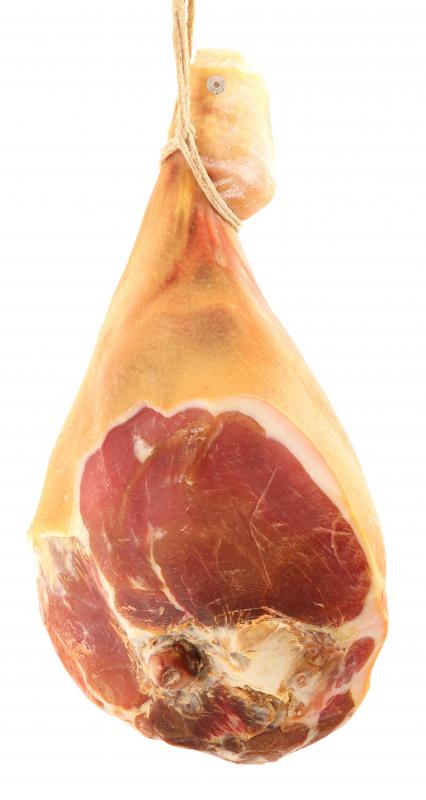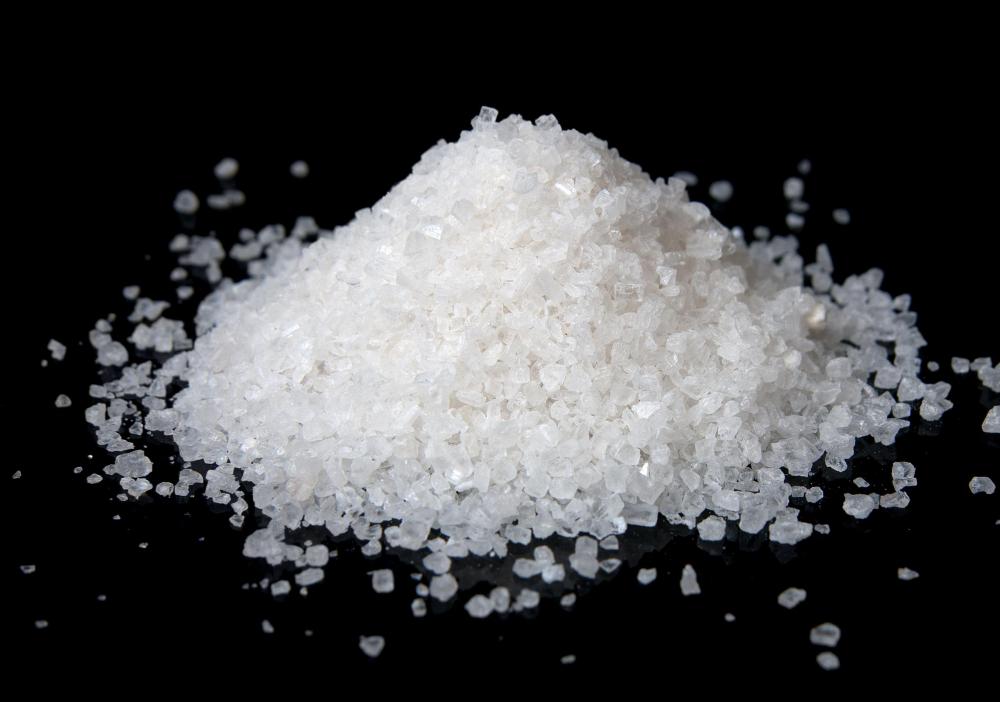At DelightedCooking, we're committed to delivering accurate, trustworthy information. Our expert-authored content is rigorously fact-checked and sourced from credible authorities. Discover how we uphold the highest standards in providing you with reliable knowledge.
What is Country Ham?
Country ham is a type of cured ham native to the American South. Unlike city ham, the more widely available ham in the United States, this type of ham is cured through a long and slow process which yields a highly shelf stable ham with a very complex flavor which some consumers liken to prosciutto and other great dry cured hams. Like other specialty hams, country ham is usually available through a boutique butcher or by special order, and some consumers prefer to order it directly through butchers in the American South.
One of the most famous country hams in the Smithfield Ham, from Smithfield in the state of Virginia. A long history accompanies the Smithfield Ham, which traditionally came from pigs fed on peanuts. While the diet requirements for pigs turned into Smithfield Hams have been relaxed, they must still come from Virginia and they usually are associated with superior quality. Kentucky, Tennessee, and North Carolina are also big ham producing states, with slightly different regional variations on their country hams.

To make a country ham, the meat is liberally salted and hung in a cool place for several weeks. The salt may be mixed with sugar for additional sweetness, and sometimes salt peter is mixed in as well, to keep the color red. Many producers also cold smoke their hams with hickory or maple smoke. Once cured, the ham is dry aged, and it loses up to 20%, and sometimes even more, of its initial weight in this process. After dry aging, the ham is packaged for sale.

An unopened country ham does not need to be refrigerated, since the curing and aging process stabilizes the meat. It is not, however, edible just yet. First, the consumer must scrape the outer layer of the ham off to remove surface salt and mold which arises during the curing process. Next, the ham must be soaked in several changes of fresh cold water for up to 30 hours to draw the salt out, or the ham will be unpalatable. Then, the ham can be baked, boiled, or fried for consumption. Some producers package ready to eat country ham, for consumers who do not want to go through this preparation process.

Even after soaking, a country ham tends to be very salty. This strong salty flavor is unappealing to some consumers, who prefer more mild brined city hams or fresh pork. Usually, this meat is used as an accent in a dish, rather than being served as a main course, since the salty flavor can get overwhelming. It goes well with pasta sauces, salads, fruit, and a variety of other foods.
AS FEATURED ON:
AS FEATURED ON:













Discussion Comments
@anon41231: Do us all a favor next time and look up the ld 50 of table salt to put things in perspective. For everyone's info, it's about the same as borax. Most of America is actually boron deficient, and boron is a required trace mineral. If you look into things, you find that supplementing with borax in the amount of 1/4 to 1/8th teaspoon in 1lt of water actually has great health benefits for most people, including balancing sex hormones /boosting testosterone in men, helping with calcium absorption, increasing fluoride excretion and lowering C-reactive protein (a.k.a. big contributor to heart problems). It does all of these things much cheaper than the big pharma solutions. Some people think this is part of the reason that after years of it being a safe substance, it was suddenly demonized.
Borax is not what real ham makers use. Sodium nitrate or pink salt is used to help preserve the meat and maintain a pinkish color. It is used in a quantity that is very low in comparison to the amount of salt used in the cure. It is used in an amount of 1/2 teaspoon to every 2 cups of salt and 1 cup of sugar. Nitrites are used in most forms of charcuteries as a preservative.
thanks anon22519. this is the recipe I have been looking for. my granddaddy told me how to do this years ago but i did not remember it.
So you use red and black Pepper. O.K., sounds good. But Borax? Borax does not sound as tasty.
Borax, sodium tetraborate decahydrate, is not acutely toxic. [8] Its LD50 (median lethal dose) score is tested at 2.66 g/kg in rats. [9] This does not mean that it is safe, merely that a significant dose of the chemical is needed to cause severe symptoms or death. The median lethal dose for humans tends to differ for a given compound from that of rats. Simple exposure can cause respiratory and skin irritation. Ingestion may cause gastrointestinal distress including nausea, persistent vomiting, abdominal pain, and diarrhea. Effects on the vascular system and brain include headaches and lethargy, but are less frequent. "In severe poisonings, a beefy red skin rash affecting palms, soles, buttocks and scrotum has been described. With severe poisoning, erythematous and exfoliative rash, unconsciousness, respiratory depression, and renal failure." [10]
A reassessment of boric acid/borax by the United States Environmental Protection Agency Office of Pesticide Programs found potential developmental toxicity (especially effects on the testes).[11] Boric acid solutions used as an eye wash or on abraded skin are known to be especially toxic to infants, especially after repeated use because of its slow elimination rate.
Maybe i'ts just me but covering one's food in poison sounds like a step you should try to skip. (especially anything that can do bad things to one's family jewels)
Fresh hams are not rubbed with salt and then hung up. They are rubbed in salt on an average for two to three days to what I call bleed out. Put it on the calendar the first day you rub them down. Then you place them in a salt box and cover them in salt. I like to place mine skin side up. They should stay in the salt averaging one to one and a half days per pound. A lot depends on the weather. Old fashioned hams are done with no electricity to keep things cool so they are done in the winter months. You don't want them to freeze but to stay cool. I then remove my hams and wash them off and rub them with a mixture of red, black pepper and borax. This keeps the skippers out. I run a wire through the hock and hang them up. A 30 pound ham needs to hang for at least a year to have the best flavor. When ready to slice just wash them real good and let them soak for an hour or so. There is no need to re soak after slicing. Cook in a cast iron skillet and after cooking all the pieces you want add a cup of coffee to the grease and you have red eye gravy. Serve with biscuits, grits and sunny side up eggs and you are in heaven. My Grandpa taught me this and he always said that you want to close the kitchen window when you are cooking ham meat or the neighbors will be over. That my friend is country ham.
Post your comments